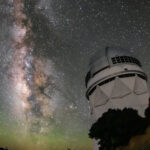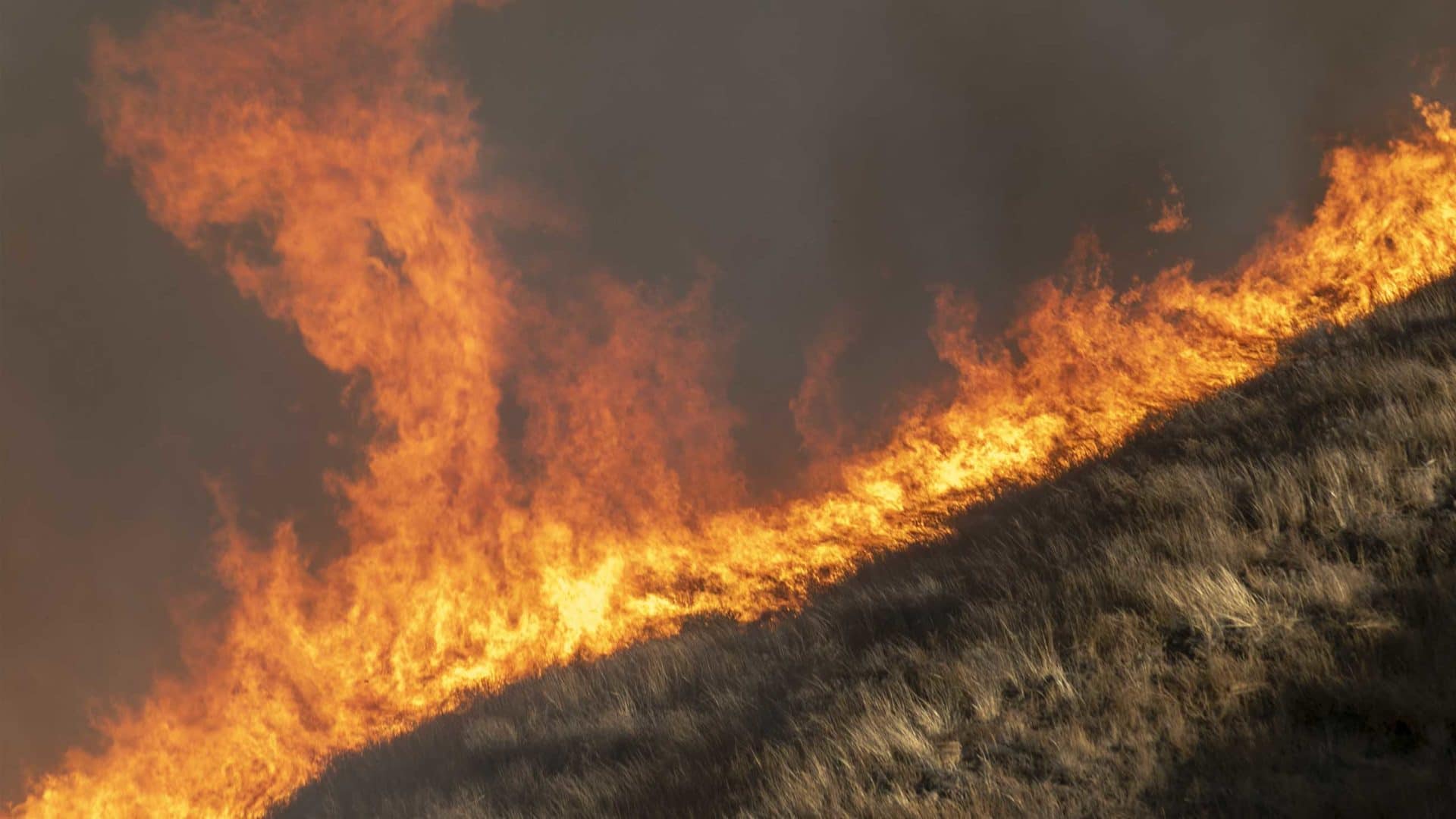Strong winds, dry terrain, and low humidity combined this week to create ideal conditions for wildfires in California, forcing thousands of evacuations. The largest active blaze, the Kincade Fire in northern California, has burned more than 120 square miles of land, and smoke pushed air quality levels across the state into hazardous territory, while utility companies cut power in an attempt to avoid sparking new blazes, leaving hundreds of thousands of people in the dark. One blaze came within yards of the Ronald Reagan Presidential Library.
Coming just one year after a wildfire season that saw both the largest and the deadliest wildfires in recorded California history, the new wave of blazes raised alarm. “It’s the end of California as we know it,” wrote New York Times columnist (and Californian) Farhad Manjoo. “California is becoming unlivable,” announced a headline in The Atlantic. “Is this the ‘new normal’?” asked USA Today.
Researchers have warned for years that a changing climate is likely to prolong the wildfire season in California and create conditions for stronger fires. At the same time, a housing crunch — the state’s major cities have some of the highest costs of living in the country — has pushed more and more people into far-flung suburbs on the edge of high-risk wildfire zones. More than 11 million people in California now live in what’s called the wildland-urban interface, a high-fire-risk population that, taken alone, would be larger than all but a handful of American states.
Human decisions helped cause this problem, but whether human decisions can help solve it is, for the moment, more difficult to tell. As with so many other climate-related disasters, the California fires are so vexing precisely because it is impossible to assign a clear, fixable cause to the wreckage. Instead, it’s a puzzling intersection of housing policy, climate policy, economics, individual decisions, and whatever mixture of carelessness, bad luck, or bad engineering sparks each individual conflagration.
What’s clear is that the impact of all this damage falls more heavily on some Californians than others. After fires, wealthier communities have been rebuilding more quickly, while poorer residents are often displaced. This week, The New York Times caught up with some people who had been driven from their homes by last year’s fires, including Jenn Wilcox, a residential care facility worker who lost her home, which was uninsured, and her job after the fire in Paradise, California.
Wilcox has moved to Georgia. “I’m a refugee,” she told The Times. “I’m broke.”
Also in the news:
• As much as a quarter of the world’s pig population could die from an epidemic of African swine fever, the World Organization for Animal Health (OIE) announced this week. Over the past year, the virus has spread rapidly across Asia, most critically impacting China, where half the global pig population resides. Already this year, China’s official inventory suggests that the virus has claimed approximately 100 million pigs, and projections from financial services company Rabobank estimate as many as 200 million could be lost by the end of this year. As a result, global pork prices are expected to continue to climb as pork production significantly decreases. Highly contagious, the virus has a fatality rate of nearly 100 percent. So far, it has been found in 50 countries, and as far west as Belgium. While the virus is not a threat to humans, the pathogen can survive in processed meats for months and frozen carcasses for years, which is one way it’s been widely transported. It also spreads to domestic pigs through contact with infected wild boar and ticks. (The Guardian)
• Twitter CEO Jack Dorsey announced via a series of tweets on Wednesday that the platform would no longer allow paid advertising about political candidates, elections, and “issues of national importance” like healthcare, climate change, and immigration. In his statement, Dorsey acknowledged the decision was motivated by a number of issues raised by critics after the 2016 U.S. presidential election, who expressed concerns about social media’s growing power to shape public discourse, target marginalized communities, spread misinformation, promote hate speech and harassment, and undermine elections. The announcement drew mixed reactions, with some politicians applauding the move as a step towards curbing misinformation, and others condemning it as censorship of free speech. Other critics have pointed out that the ban is likelier to harm smaller grassroots campaigns than incumbents who already have large followings on the social network, and the potential danger in Twitter employees deciding which topics are deemed political and therefore banned from paid promotion. On the other hand, Facebook CEO Mark Zuckerberg has also come under fire recently from politicians, advocates, and his own employees for his decision to allow political ads on the platform without any measures to fact-check their content. (The Washington Post)
• A surprise announcement has put a high-profile climate meeting in limbo. On Wednesday, Chilean president Sebastián Piñera said that the country will no longer host the United Nations’ 25th Conference of the Parties (COP25), a round of international climate negotiations that was to be held in Santiago in early December. An international trade meeting scheduled for Santiago this month, the Asia-Pacific Economic Cooperation summit, was also cancelled. The announcements come as a response to protests that have gripped the South American capital and escalated to violence in recent weeks. In a statement, U.N. Climate Change Executive Secretary Patricia Espinosa said the organization is “exploring alternative hosting options.” Nevertheless, Chile’s abrupt pullout casts uncertainty on a meeting that was seen as an important precursor to next year’s COP26 climate meeting, at which signatories of the Paris Climate agreement will update their climate pledges. Greta Thunberg, the teenage climate activist who sailed across the Atlantic earlier this year and has been gradually traveling toward the Santiago climate summit, tweeted that her travel plans are now on hold. (The New York Times)
• A new analysis of the planet’s rising seas, published this week in Nature Communications, found that many coastal cities face a far greater risk of flooding – with some now projected to go completely underwater by the century’s end – than previously thought. The study, done by researchers at the non-profit environmental organization Climate Central, used artificial intelligence to correct for long-known, troubling errors in calculations of elevation. Old satellite imaging tools, for instance, tended to focus on tree tops and tall buildings, giving the impression that cities were higher and safer than they actually are, a problem that scientists describe as “positive vertical bias.” The corrected data tripled the estimate of coastal area vulnerable to flooding driven by human-caused climate change. Although the researchers issued new warnings for many American cities, from San Diego to Boston, the direst findings involved Asia. “Southern Vietnam could all but disappear,” noted The New York Times in its story. And although the worst effects are projected for the end of century, scientists also warn that the risks are accelerating. At the least, the researchers warn, some 150 million people around the world will be living below high-tide levels in 2050. (New York Magazine)
• An article published in Nature on Monday claims to have traced the geographical origins of mankind to the region surrounding the Makgadikgadi Pans salt flats, in what is now northeastern Botswana, based on an analysis of the mitochondrial DNA of 1,217 people from southern Africa. However, the team’s findings have already generated controversy, with many experts expressing immediate skepticism. Critics say that the study is based on just a small portion of DNA from living people and does not account for the rest of the genome. Others have expressed concern that the team overlooked many ancient human fossils, and disregarded archeological artifacts, such as stone tools. In addition, critics cite archeological evidence suggesting that our human ancestors came from a variety of locations and arose earlier than the 200,000 years estimation made by the authors of the paper. (The Atlantic)
• And finally: While healthcare access and quality has been steadily improving in Afghanistan over the last two decades, a moving visual tour of the country’s hospitals and clinics published this week by Undark suggests that challenges abound. In a country of more than 37 million people, wrote photojournalist Kern Hendricks, Afghanistan has just 150 hospitals and a mere three doctors per 10,000 people — a small fraction of the nearly 26 doctors per 10,000 people in the United States. “As of 2015, the country had just five hospital beds per 10,000 people, compared to approximately 30 hospital beds per 10,000 people in the U.S. in 2013 and 134 per 10,000 in Japan in 2012,” Hendricks noted. The result is a vast tableau of deprivation and adaptation, where doctors and nurses use their own funds to buy needed equipment and supplies, and fashion makeshift surgical tools where proper ones are unavailable. Meanwhile, doctors and other health workers often face direct physical threats for treating members of competing factions, prompting many professionals to leave the country in search of safer and higher paying healthcare jobs abroad. The series of photographs, taken at several medical facilities in Kabul, as well as far-flung rural districts in the north and the east, bear stark witness to the many hurdles Afghanistan faces as it tries to overcome decades of conflict. “Sometimes we don’t have [clean] water in [the operating theater] for hand washing,” one surgeon told Hendricks. “This is very important.” (Undark)
“Also in the News” items are compiled and authored by Undark’s staff and interns.










